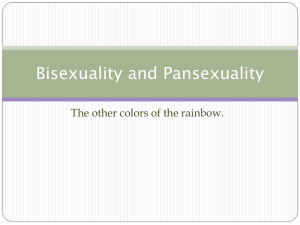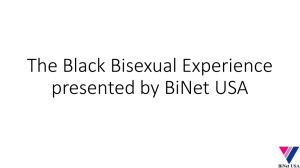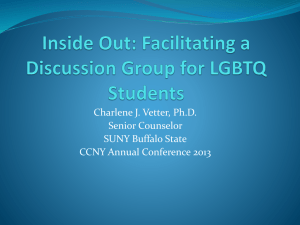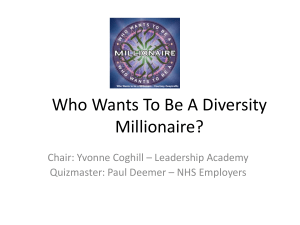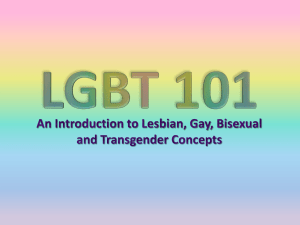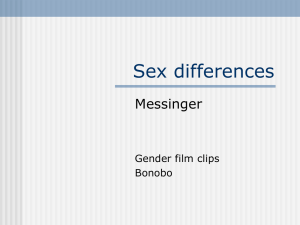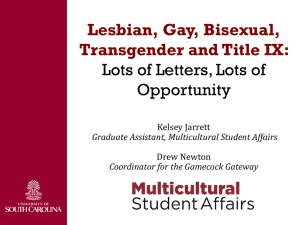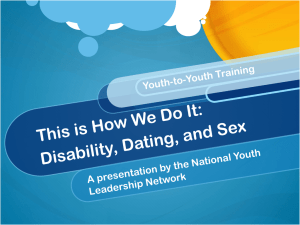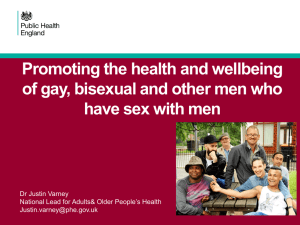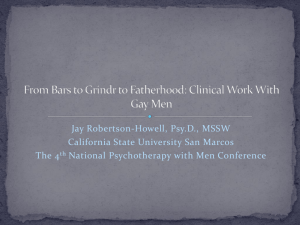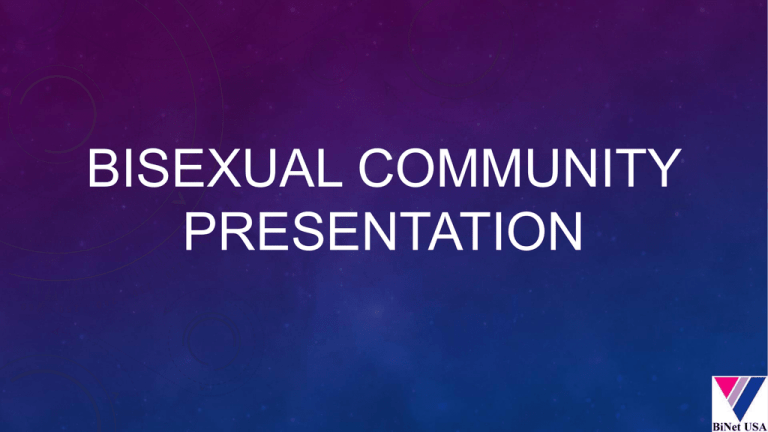
BISEXUAL COMMUNITY
PRESENTATION
IMPORTANT MOMENTS IN BI
HISTORY
1966 - First U.S. student gay rights group is co-founded by
bisexual activist, Stephen Donaldson. Donaldson feels
forced out of the gay movement after an affair with a leader
from Daughter of Bilitis, the first lesbian civil rights group.
1969 - Brenda Howard (know as "Mother of Pride")
conceives and coordinates a week of "PRIDE" activities to
commemorate the Stonewall riots.
1974 - Dr. Fritz Klein publishes The Bisexual Option: A
concept of one-hundred percent intimacy, goes on to found
American Institute of Bisexuality and Journal of Bisexuality.
1977 - Alan Rockway, a psychologist and bisexual activist,
co-authors the nation's first successful gay rights ordinance
put to public vote, in Dade County, Florida.
1979 - Black LGBT icon and bisexual activist ABilly S.
Jones-Hennin serves as logistics coordinator for first
National March on Washington for Lesbian and Gay Rights.
Left: Stephen
Donaldson
Below: ABilly
S. JonesHennin
MORE MOMENTS IN BI
HISTORY
1984 - After a two year battle, BiPOL activist, AIDS educator, and
therapist Dr. David Lourea persuades the San Francisco
Department of Public Health to recognize bisexual men in their
official AIDS statistics.
1987 - A contingent of 75 bisexuals marches in the 1987 March On
Washington For Gay and Lesbian Rights. The first national bisexual
organization is conceived at this gathering, The North American
Bisexual Network. NABN would later change its name to BiNet
USA.
1992 - The Bisexual Connection (Minnesota) sponsors the First
Annual Midwest Regional Bisexual Conference. BECAUSE
(Bisexual Empowerment Conference: A Uniting, Supportive
Experience) has run every year since.
1993 - Originally founded in 1985, The East Coast Bisexual
Network revises its mandate and changes its name to the Bisexual
Resource Center (BRC).
1999 - BiNet USA coordinators Michael Page, Gigi Raven Wilbur,
and Wendy Curry organize the first Celebrate Bisexuality Day
Image courtesy of "Biconic Flashpoints: 4 Decades of Bay
Area Bisexual Politics" history exhibit at GLBT History
Museum in SF
BISEXUAL = HISTORICAL
SIGNIFICANCE
From the 1990 Bisexual Manifesto:
• Bisexuality is a whole, fluid identity. Do not
assume that bisexuality is binary or duogamous
in nature: that we have "two" sides or that we
must be involved simultaneously with both
genders to be fulfilled human beings. In fact,
don’t assume that there are only two genders.
Do not mistake our fluidity for confusion,
irresponsibility, or an inability to commit. Do not
equate promiscuity, infidelity, or unsafe sexual
behavior with bisexuality. Those are human
traits that cross all sexual orientations.
Nothing should be assumed about anyone’s
sexuality, including your own.
BISEXUAL DEFINITION
© Robyn Ochs www.robynochs.com
“Bisexuals are people
who acknowledge in
themselves the potential
to be attracted –
romantically and/or
sexually – to people of
more than one sex and/or
gender, not necessarily
at the same time, not
necessarily in the same
BI COMING OUT PROCESS IS
UNIQUE
More stages than gay/lesbian coming out
Final stage is different and includes continued “identity
maintenance”
Coming out later in life
© Bi Psychologist Dr. Mimi Hoang, drmimihoang@gmail.com
Pic: 2013 Bi
Community
Issues
Roundtable at
the White House
Attendees
LABELS ARE IMPORTANT TO
US
• Bisexual is a Community Identity Label
(similar to “lesbian,” “gay,” “straight,” or
“queer”).
• Many bisexuals use Personal Identity
Labels that serve a vital function in
describing differences while giving each
individual a space to be unique.
• Personal Identity Labels can include (but
would never be limited to): fluid,
multisexual, non-monosexual, pansexual,
polysexual, pomosexual, and omnisexual.
Image courtesy of The Bisexual Resource Center
• The internal conversation between bi, pan,
fluid, queer community members about
labels should not be used as a rationale for
not serving the needs of the same
BISEXUAL IDENTITIES
• “Bisexual or Pansexual?” can be
considered equivalent to internal
community conversations many gay
and lesbian people have regarding
personal approaches (e.g.
“masculine,” “butch,” or “femme”).
• Don’t “identity police” but DO spend
time acknowledging the diversity that
exists within the “B in LGBT”
2014 Poll on bisexual labels by The BiCast (a bi podcast)
• Bi people can “come out” while in a
same-sex or different sex
relationship. Coming out as bisexual
does not itself indicate a person’s
relationship status (e.g. single) or
relationship type (e.g. monogamous).
THE B IS IMPORTANT FOR THE
LGBT COMMUNITY
Source, Williams Institute
BISEXUAL DATA COLLECTION
• Williams Institute guidelines recommend using
bisexual when collecting LGBT data, and BiNet
USA recommends using bisexual when
developing resources or support opportunities.
• Transgender people can also be straight, gay,
lesbian, bisexual, queer or asexual. Please
allow them to id as such.
• Add a “bi-claimer” whenever possible:
• “The term bisexual will be used as an
inclusive term to mean romantic and/or
sexual attraction to more than one gender,
and includes pansexual, fluid, omnisexual,
and queer self-identifications”.
WE FACE EXTREME HEALTH
DISPARITIES
Higher rate of tobacco use, compared to
heterosexuals, lesbians and gays.
Higher rate of anxiety or mood disorder
compared to heterosexuals, lesbians and
gays.
Bisexual women are the most likely to
have never had a cancer screening
(mammogram or pap test) compared to
heterosexuals or lesbians.
Bisexual women have more risk factors for
heart disease compared to heterosexuals
or lesbians.
Heterosexuals
Best health in
relation to
sexual
orientation
Gays and
Lesbians
Bisexuals
Source: Out For Health, Healthy People 2020 Bisexual Fact Sheet
Poorest health
in relation to
sexual
orientation
MENTAL HEALTH
• Bisexuals suffer higher rates of every
mood and anxiety disorder.
• Bi women also had more anger, selfinjury, and suicidal ideation and
attempts.
• Among women, bisexual women had
highest prevalence of PTSD (26.6%
versus 6.6% of the heterosexual
reference group).
• “..the high prevalence of PTSD
among sexual minorities in early
adulthood potentially sets the
stage for poorer health throughout
adulthood” - American Journal of
Public Health, 2012
Source: Out For Health, Healthy People 2020 Bisexual Fact Sheet
Memes from disruptingdinnerparties.com and keepcalm-o-matic.co.uk
SUICIDALITY
SERIOUSLY CONSIDERED OR ATTEMPTED SUICIDE
50%
45%
45%
40%
35%
35%
30%
30%
25%
25%
20%
15%
10%
10%
7%
5%
0%
Bi Women
Bi Men
Lesbians
Gay Men
Hetero Women
Source, Out For Health, Healthy People 2020 Bisexual Fact Sheet
Hetero Men
BI WOMEN AT INCREDIBLE
RISK OF RAPE
Most studies reveal
that approximately
50% of transgender
people experience
sexual violence at
some point in their
lifetime – Journal of
Aggression and
Violent Behavior
Sources: Walters, M.L., Chen J., & Breiding, M.J. (2013). The National Intimate Partner and Sexual Violence Survey (NISVS): 2010 Findings on Victimization by
Sexual Orientation. Atlanta, GA: National Center for Injury Prevention and Control, Centers for Disease Control and Prevention.
AGE AT TIME
OF FIRST
COMPLETED
RAPE
“Compared to lesbians, bisexual
women reported more severe
VICTIMIZATION
adult sexual victimization
experiences, greater
revictimization, riskier drinking
patterns, and more lifetime male
sexual partners.” –2013 Journal
of Violence against women
Sources: Walters, M.L., Chen J., & Breiding, M.J. (2013). The National Intimate Partner and Sexual Violence Survey (NISVS): 2010 Findings on Victimization by
Sexual Orientation. Atlanta, GA: National Center for Injury Prevention and Control, Centers for Disease Control and Prevention.
SEXUAL VIOLENCE IS A UNIVERSAL
DISPARITY
78% of bisexual men
report having only
female perpetrators of
IPV
Sources: Walters, M.L., Chen J., & Breiding, M.J. (2013). The National Intimate Partner and Sexual Violence Survey (NISVS): 2010 Findings on Victimization by
Sexual Orientation. Atlanta, GA: National Center for Injury Prevention and Control, Centers for Disease Control and Prevention. Stotzer, R. (2009). Violence against
transgender people: A review of United States data. Aggression and Violent Behavior, 14, 170-179.
INTIMATE PARTNER VIOLENCE
Adult bi women reported
highest levels of
physical violence, rape,
stalking and
psychological
aggression in NISVS.
90% of bisexual women
report having only male
perpetrators of IPV
Sources: Walters, M.L., Chen J., & Breiding, M.J. (2013). The National Intimate Partner and Sexual Violence Survey (NISVS): 2010 Findings on Victimization by
Sexual Orientation. Atlanta, GA: National Center for Injury Prevention and Control, Centers for Disease Control and Prevention.
Our Stories: Intimate Partner
Violence
The shelter staff told me I didn’t belong
there, that they only served women abused
by male partners. They referred me to a
new gay community anti-battering project.
That group also turned me away, saying
that I was bisexual, not gay, so they couldn’t
help me. What I felt too angry and defeated
to say back then was, “Why can’t services
be designed with bisexuals in mind? If we
design services sensitive to bisexuals, they
end up being responsive to both
heterosexual and gay people, too, don’t
they?” – From statements read at the 2013
Bisexual Community Issues Roundtable at
the White House.
Domestic Violence Brochure for Bi People
from theNetworklaRed
POVERTY
Source, Williams Institute
FUNDING
DISPARITIES
PRESENT IN
BOTH PUBLIC
AND PRIVATE
SERVICE
PROVIDERS
AND
FUNDERS
Source, "40 Years Of LGBT
Philanthropy" by
LGBTFunders.com
BISEXUAL WORKPLACE
DISCRIMINATION
2010 Survey* of
Discrimination
Experiences
2012 Survey** of
Discrimination
Experiences
Not hired
10%
13%
Fired
7%
5%
Unfair review
13%
20%
Denied promotion
10%
13%
Denied opportunity
17%
7%
Sexual harassment
25%
31%
Anti-bi jokes
46%
58%
*Source: Green, Payne, Green; “Working Bi: Preliminary Findings from a Survey on Workplace Experiences of Bisexual
People;” Journal of Bisexuality.
**Source: Tweedy & Yescavage; “Employment Discrimination Against Bisexuals and Others with Fluid Identities;” Social
Science Research Network.
BISEXUAL STIGMA
Bisexual women often
report higher rates of
depression and mental
health problems than their
heterosexual and lesbian
counterparts. These
disparities likely occur, in
part, as a result of the
unique stigma that
bisexual women face and
experience. Such stigma
can in turn operate as a
stressor, thereby
contributing to poor
mental health status.
- Journal of Bisexuality,
2012
Whites
Catholics
Least stigmatized by
heterosexuals
Blacks
Jews
Pro-Lifers
Pro-Choicers
Lesbians
Gay Men
Bi Women
Posted on BiNet USA FB Group by college student
Bi Men
IVDU
Most stigmatized by
heterosexuals
Source: Herek, Gregory M. “Heterosexuals' Attitudes Toward Bisexual Men and Women in the United States” University of California at Davis,
2002
ADDRESSING THE STIGMA OF
BISEXUALITY HELPS SAVE LIVES
Examples of anti-stigma campaign done by the Centre for Addiction & Mental Health, Toronto.
Posters, buttons, and postcards available for sale at http://www.rainbowhealthontario.ca/rhostore
RECOMMENDATION
•
S
Develop bisexual-specific trainings, flyers, publications and
a bisexual-specific curriculum or bisexual modules for
LGBT curriculum.
•
•
•
•
CNN.com, 2014
•
Create an OPENLY bi affirming organization by displaying
bisexual affirming posters, flyers and publications.
Work to remove heterosexist and homosexist assumptions
from all LGBT outreach material. Do not presume that all
transgender individuals are “straight” and understand that
bisexual people in different-sex relationships still face
health, mental health, safety and social disparities.
Research is always more actionable if you see individual
LGBT communities, so break out individual groups when
possible.
Regularly email, tweet, Facebook and Instagram content
friendly to and inclusive of bisexual communities.
Have a bi flag on hand for Celebrate Bisexuality Day on
September 23rd of every year.
The Bisexual Resource
Center created
#BiHealthMonth for the
month of March and is
interested in working
with LGBT organizations
to develop more bi
resources.
www.biresource.net
RECOMMENDATION
•
S
•
Use bi inclusive language, and a bi-claimers whenever
possible:
“parents in the LGBT community” and “LGBT
couples”
•
•
Disruptingdinnrparties.com, 2013
•
•
RCH2411 Photography
Different-sex and same-sex to refer to relationship
type instead of “gay” or “straight” couples.
When referencing a bi identity like “pansexual”,
consider including others like “fluid” or “queer” so
it’s clear you support bi diversity. BPFQ FTW!
Create strong relationships with local bisexual
orgs, see list on www.binetusa.org/bi-groups-inthe-us
Maintain working relationships with BiNet USA
and other national bi orgs who regularly interact
with the bi community. BiNet USA regularly
reaches over 25k users via social media,
QUESTIONS AND COMMENTS

